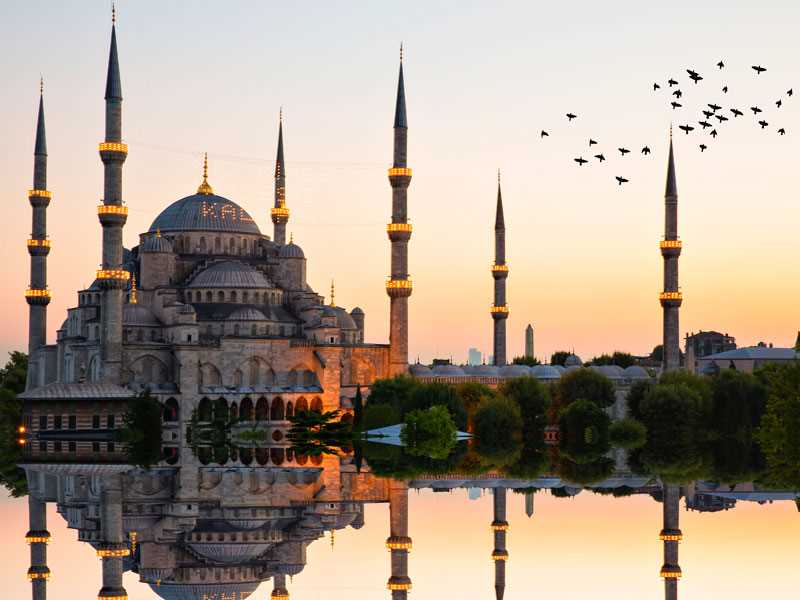Sultan Ahmet Mosque, also known as the Blue Mosque, is one of the most beautiful mosques not only in Turkey but also in the world. The Mosque of Sultan Ahmed has a great deal of interest from the Turks and the Arab and foreign tourists, where no tourists coming to Istanbul from any country in the world can not visit Sultanahmet Mosque.
The mosque is located in the Amenio district of Sultanahmet Square opposite the Hagia Sophia Museum in the European section of Istanbul.
The mosque was designed by the architect Sadafkar Muhammad Agha, a student of the architect Sinan Agha who became the chief architect after the death of the architect Sinan. The mosque was built by order of Sultan Ahmed I with a large opening ceremony in 1609 AD and was completed in 1616.
The mosque of Sultan Ahmed is one of the largest mosques in Turkey and is known by the West as the Blue Mosque because of the plant paintings used in the mosque. There are more than 20,000 pieces of Chinese pottery decorated with vegetal figures. Rev. Oleya Shalabi said that seven palaces were demolished in order to build the mosque. The mosque has special value because it is one of the last samples of classical Ottoman architecture.
This mosque is one of the mosques in Istanbul with six mausoleums. The four minarets with three balconies were built on the four corners of the mosque and the two short two-porch buildings were built on the two Baha'i angles. The diameter of the base dome is based on columns 33.6 m and height of 43 m and supported by four half-domes.
The area of the mosque is 64 x 72 m. It has 260 windows for lighting the mosque. Around the mosque on the front and sides is a square surrounded by walls with eight-door windows. The courtyard features a marble fountain surrounded by thirty domes. The decorative motifs of carnations used in the fountain attract the viewer's beauty and beauty.
The courtyard of the mosque is accessed through three doors with a staircase. These three doors and all the doors of the mosque are made of bronze.
The mosque is full of carpets, carpets and chairs, as well as stained-glass windows, which are decorated with handprints, which overlooks the mosque with the hallmarks of Byzantine and Ottoman architecture, as well as its location overlooking the Marmara Sea and its counterpart to the Hagia Sophia Museum.
Date of construction of the Mosque of Sultan Ahmed
After the Treaty of Zetvatorok and the undesirable outcome of the war with the Safavid state, Sultan I decided to build a huge mosque in Istanbul, the first Sultanite mosque to be built in more than forty years. While the former sultans were working to pay money to build their mosques based on the spoils of war, Sultan Ahmed withdrew money from the state safe to build the mosque because he had little victory over his enemies.
The building of the mosque was to have taken place in the palace of the emperors in the face of Hagia Sophia (which was then the largest mosque in Istanbul) and the Bodrum of Constantinople, a place of great symbolic significance as the cultural and sporting center of Constantinople, the capital of the Byzantine Empire. Large parts of the southern part of the mosque are built on the foundation and burial grounds of the Great Palace. Many of the palaces were already built there, the most famous of which was the palace of Sokolly Mohammed Pasha, so they had to buy them at a very high price and then buy them. Large parts of the Safendon (the domed U-shaped domes of the Hepodrum) were removed to make room for the new mosque.
The mosque was built in August 1609 when Sultan Ahmed himself took the first ax in the construction of the mosque. This work clarified his intention to be the first mosque in his state. He appointed His Royal Highness the architect Sadafkar Mohammed Agha as a pupil and assistant The famous architect Sinan Agha to be responsible for construction. The organization of the work was meticulously described in 8 volumes and is currently in the library of the Tupp Capi Palace. The opening ceremony was held in 1616. The mosque was not completed in the final year of the reign of Sultan Ahmed I, and the final costs of the construction were completed by his successor Mustafa I.








